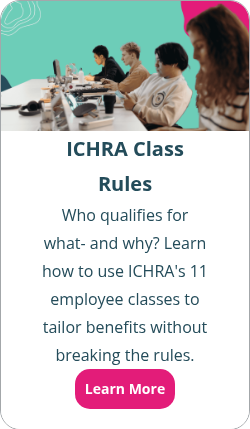ICHRA reporting requirements: What you need to know
By Chase Charaba on December 13, 2023 at 4:36 PM
As the year comes to a close, end-of-year reporting is at the top of many employers' and plan administrators' to-do lists—especially for business owners administering their own health benefits, like a health reimbursement arrangement (HRA).
One of the most popular types of HRAs is the individual coverage HRA (ICHRA). A key feature of the ICHRA is that all reimbursements for qualifying medical expenses, such as individual policy monthly premiums, are free of payroll taxes for employers and employees. Reimbursements are also free of income tax for employees with a qualifying individual health plan that offers minimum essential coverage (MEC).
Even though the ICHRA is free of payroll and income taxes—making it free of W-2 reporting requirements—you need to satisfy other requirements. This article will answer frequently asked questions about ICHRA reporting requirements.
What is ICHRA?
An ICHRA is an employer-funded plan that allows organizations of all sizes to reimburse employees for their qualifying medical expenses and individual health insurance plan premiums. An ICHRA is often a more affordable and personalized option than a traditional group health plan.
Employees pay for their health plan coverage and medical care costs. They provide proof of those purchases to their employer as claims for reimbursement. Then, their employer reimburses eligible expenses up to their allowance amount.
With an ICHRA, employers can establish monthly reimbursement amounts and design their plan with classes of employees. For example, you can offer different allowances to seasonal employees and temporary employees or choose only to offer an ICHRA to your salaried employees.
This gives employers complete cost control over the benefit while employees have the freedom to choose an individual health plan that best fits their needs.
How do you report ICHRA on Form W-2?
First, let's discuss ICHRA W-2 reporting requirements. While the Affordable Care Act (ACA) requires employers to report the cost of employer-sponsored group health plans, the IRS1 doesn't require ICHRA reporting on Form W-2.
There's no need to report your ICHRA benefit on your eligible employees' W-2s. However, if you offer other types of HRAs, such as a qualified small employer HRA (QSEHRA), there are specific W-2 reporting requirements in place for small employers.
ICHRA reporting requirements for small employers
If you have fewer than 50 full-time equivalent employees (FTEs) at your organization, there are forms you must submit to the IRS to remain compliant.
Small employers must complete the following reporting obligations:
- Submit Form 1094-B2 and Form 1095-B3 to the IRS
- Form 1095-B provides information about the coverage your organization offers to employees. You must submit a Form 1095-B for every employee who had an ICHRA during the plan year.
- Form 1094-B is a summary sheet that includes the total number of Form 1095-Bs submitted to the IRS.
- Send employees Form 1095-B
- Each form includes codes that tell your employees how you calculated their affordability. You must provide this form to all full-time employees, including those who were full-time for at least one month during the tax year.
Employers must provide this information to employees by January 31. These forms are due to the IRS by February 28 for paper filers and by March 31 if filing electronically.
ICHRA reporting for applicable large employers (ALEs)
Applicable large employers (ALEs), or organizations with 50 or more FTEs, must meet the ACA's employer mandate to provide employees with healthcare coverage. ALEs that meet the employer mandate with an HRA must also demonstrate that the amount they’re reimbursing employees for is enough to make individual health coverage affordable.
To be affordable, reimbursement allowances must be enough that the lowest cost silver tier insurance plan on the ACA marketplace or state exchange is no more than 9.96% of the employee's household income for 2026 and 9.02% for 2025.
Large employees must complete the following tasks to maintain compliance:
- Submit Form 1094-C4 to the IRS
- This provides information about the coverage you offer to employees
- You must include every full-time employee from the tax year and every part-time employee who enrolled in your ICHRA
- Send Form 1095-C5 to your employees
- This includes codes that tell employees how you calculated affordability. You must provide this form to all employees that were full-time for at least one month
Employers must provide this information to employees by January 31. These forms are due to the IRS by February 28 for paper filers and by March 31 if filing electronically.
Form 5500
Under the Employee Retirement Income Security Act of 1974 (ERISA), all organizations that offer retirement and welfare benefits, including ICHRAs, must file Form 5500. This details your benefit plan's financial condition and operations for the year.
PCORI fees
No matter your organization's size, all employers with self-insured plans like an ICHRA must pay a yearly fee for the Patient-Centered Outcomes Research Institute (PCORI) and submit Form 720.
The PCORI fee amount for plan years ending before October 1, 2024, is $3.22 per covered life. The fee for plan years ending on or after October 1, 2024, is $3.22 per covered life.
This fee is due by July 31 following the plan year. While this fee was set to expire in 2019, the Further Consolidated Appropriations Act of 2020 extended it through 20296.
ICHRA reporting for employees
Employers aren't the only ones with end-of-year reporting and tax responsibilities—there are a few requirements for employees as well.
Employees using an ICHRA should be aware of the following:
- To participate in the ICHRA and receive tax-free reimbursement, employees must have minimum essential coverage (MEC). Employees who don't have MEC have to pay income taxes on all reimbursements they receive.
- Employees can typically see reimbursements on their pay stubs as an addition to their net earnings (wherever the employer or payroll provider typically lists such additions).
Conclusion
With HRAs, organizations can save on healthcare costs by giving employees a tax-free health benefit. Best of all, unlike traditional group health insurance plans, employers can achieve these tax savings with just a few tax forms and a small fee per covered employee.
Keep in mind that while we're experts on HRAs and employee benefits here at PeopleKeep, we're not tax professionals. Contact your accountant for more detailed tax information if you have more specific questions about tax reporting.
This blog article was originally published on November 22, 2020. It was last updated on December 13, 2023.
- https://www.irs.gov/affordable-care-act/form-w-2-reporting-of-employer-sponsored-health-coverage
- https://www.irs.gov/forms-pubs/about-form-1094-b
- https://www.irs.gov/forms-pubs/about-form-1095-b
- https://www.irs.gov/pub/irs-pdf/f1094c.pdf
- https://www.irs.gov/pub/irs-pdf/f1095c.pdf
- https://www.irs.gov/pub/irs-drop/n-20-44.pdf
Check out more resources
See these related articles

HRAs and W-2 annual reporting
Learn about HRA W-2 annual reporting requirements. Understand what employers need to include on employees' W-2 forms for HRA compliance.

What is an EEO-1 report?
Learn about EEO-1 reporting and why it's essential for companies to submit accurate data. See how to navigate the reporting process effectively.

Are HRAs subject to Medicare Secondary Payer (MSP) requirements?
If you have employees that are on Medicare and participating in an HRA, you need to make sure you're coordinating and reporting the two benefits correctly.



